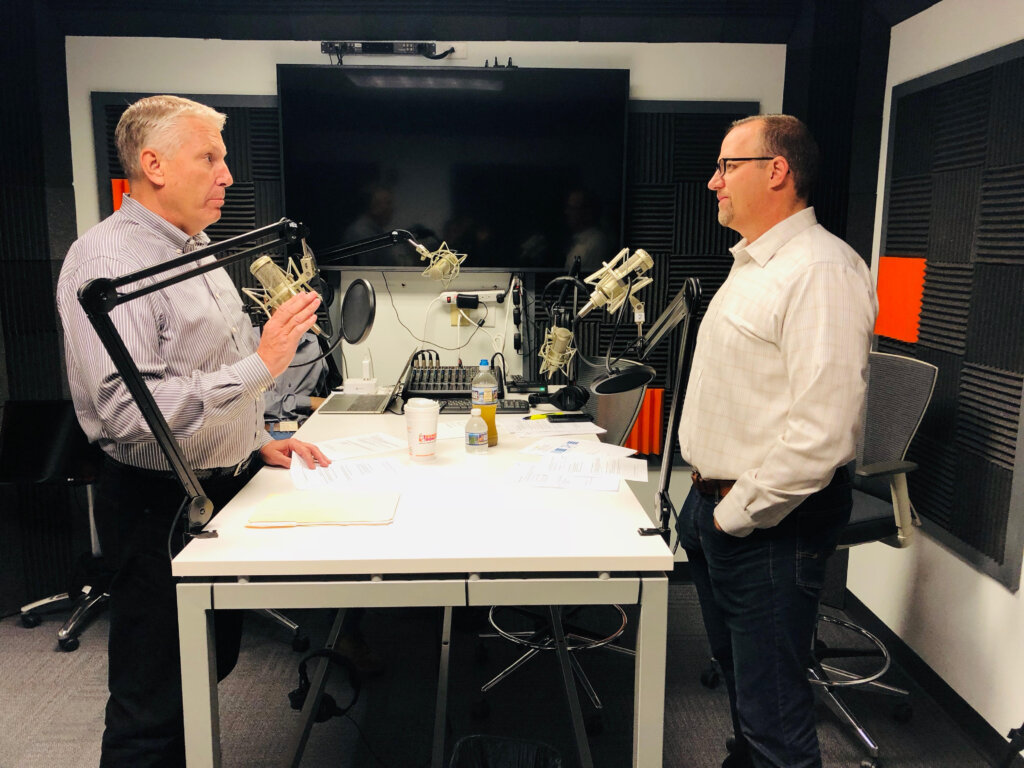Maxwell Executive Leadership Podcast #24: Connecting: Five Generations Deep

It’s the first time in history that we have five generations together in the workforce. With that comes many opportunities, but also many challenges for leaders today. In Episode #24 of our Executive Leadership Podcast, The John Maxwell Company’s Chris Goede and Perry Holley will explore each of these generations and how they like to be led which requires a very intentional, deliberate and planned leadership approach.
Listen to all podcasts in this series and subscribe to new episodes on iTunes– or Google Play.
Read the transcript below:
Welcome to the John Maxwell Company Executive Leadership Podcast where our goal is to help you increase your level of influence, increase your reputation as a leader, and increase your ability to fully engage your team to drive remarkable results. Hi, I’m Perry Holley, a John Maxwell facilitator and coach and I’m Chris Goede, Vice President of The John Maxwell Company. Welcome and thank you for joining.
Today’s topic is ‘Connecting: Five Generations Deep’. You know, what’s interesting about this is you brought this up to me just recently and I thought it was fascinating and I’m so glad we’re talking about it today to where it’s really the first time in history that we have five generations in the workforce and I know a lot of people just talk about one of the generations they have a problem with and now we have five. And, so with that comes some incredible opportunities to lead, but also it creates some challenges for leaders today. So let’s talk a little bit about that. What are some of those challenges that our leaders are going to face with five different generations in the workforce?
Yeah. I love this topic because there’s so much to know about it. My tip right away would be spend some time thinking about your team and where they are, but I remember when I first became a parent and then we had our second child and I started leading the second child the same way that I led the first. One was a boy, one was a girl, one was older, one was younger and it took me a while to figure out they do not respond to the same stimuli the same way. And I was struggling with, you know, connecting. That’s really what it comes down to for me is that as a leader you really want to connect with the people on your team. You really need to meet them where they are and you’re trying to take them to a new place, but you’ve got to start where they are and their motives and values can be different across the different generations.
And I hadn’t really thought about this until I took a step back and looked at my team and said, wow, I’ve got some older folks, some younger folks and some really younger folks that are coming in. We’re hiring at an all time level of young folks coming out of university. If you’re not intentionally learning about what makes these different folks tick, you’re setting yourself up to for disengagement and it’ll affect your ability to develop influence with people. It’ll hurt your credibility as a leader. I think it’s a lot wrapped up in this one.
Well, I know you’re sitting there thinking, wow, leadership is already hard. Now you’re telling me I have to figure out five different ways to lead people. A lot of us, including myself, have a hard time leading myself. So, let’s do this. Let me set the stage because what we want to do is we want to give you some tools, some thoughts and different ways to lead these different generations. And, what I want to do is start by just kind of giving you the breakdown of how we’re breaking down these different generations, according to the Pew Research Center. So the first one we call a silent or the traditionalist generation for those born 1928 and 1945. Then we have the baby boomers born between 1946 and 1964, Generation X, born between 1965 and 1980. Then we have the Generation Y or as we know, the Millennials, which seemed to get a lot of our attention these days are born between 1981 and 1997. And then finally we have Generation Z born after 1997 and then probably coming soon, Generation 2020. This is crazy.
So let’s look at some of the differences between these generations and how we need to lead and how do we need to adapt our leadership style to them. Because remember, one of the overlying principles of our foundational beliefs is we need to lead people the way they need to be led, not the way we need to be led. And that’s our responsibility as a leader. And so to kind of frame this up, Perry, let’s look at it a couple different ways. Maybe the first way, how you communicate as a leader to them, how you set expectations and performance and hold them accountable. And then the third part is providing feedback and coaching to them.
And so what we’re looking at here is really levels two, three and four when it comes to each one of these generations. So let’s start with the traditionals generation and here the 1928 to 1945. Obviously these are some things that we pulled out that will relate to this. The Great Depression. There’s a strong sense of rules in order. A lot of hard work values, conformity, working toward the common good. You kind of get the picture there. So talk to us a little bit about this generation in regards to those three areas.
Yeah, and in full disclosure, I would, I’m going to put where I was because I want to relate this to me was that, I will fall into the Baby Boomer. I’m late, very late, extremely late Baby Boomer years. Can I make that clear? So this would be the traditionalist or the silent generation. They were silent. I looked that up to why do they call them silent was because if you compare them to the Baby Boomers were protesting the silent, the traditionalist. So this will be my parents. If I had my parents in the workforce and going into the framework you set up, if I were going to, look at it communicating, which I think is, you should always be looking at how do you communicate with the different generations. This one’s going to be more formal. They come up with rules as you mentioned and hard work. And they just want to have the formal communication. That might be an email, it might be written communication, it could definitely be face to face, but it’s going to be the fact structure. Yeah, good word. I said clarity of expectations that they really value a clear timeline and goals. They want to know what do you when you want it by. And I need to be aware of that. When I think of measurement, hey put that one in there, you didn’t mention that, but I was looking at they want to know and most generation everyone was what does a win look like, but especially this generation is what are we aiming for and you think about their come from and coming out of the depression and some of the tough things that they did and they’ve made good money but they save a lot of money and they’re very frugal and they have a very fine plan for things.
And then I look at feedback in my mind I thought they don’t really care for it so much it, if I’m not doing it right then tell me otherwise just keep it to yourself. It was way the I felt and some of the folks on my team, but I did put a bonus value on this one for myself, which was, these are fantastic people on the team to be mentoring some of the younger folks on the team. They have a lot of knowledge, a lot of experience, a lot of value to share. And if we’ll play that right on the team, they can actually help me lead the team. I really like that.
That’s awesome. Okay. The second one, you briefly mentioned, this one, the Baby Boomers. Yeah your peeps. Very large group, right? This is a post World War II. Really optimistic. There’s a clear sense of right and wrong, rebelled against the authority, as you mentioned a little earlier. Love experimentation. They work hard, a lot of hard work there and then visible signs of success. Talk to us about leading them.
Yeah. Go back to our framework. I said if I’m communicating with my own generation, it’s gotten more personal and wants to be personal and maybe in person communication. They’re not that formal style that we came from the generation before. When it comes to expectations, they really value freedom to direct their own work. If you just tell me what you want, I’m thinking that, let me figure out how to get there. A little bit of that autonomy thing going on. Clarity of measurement. Tell me what a win looks like and get out of my way. That autonomy shows up in me. I want to get there on my own. Feedback. I’m thinking you need to. I’m okay going in on my own, but, you know, I’ll listen to feedback, but it hasn’t been prevalent in this generation. I think is you’re going to see in some of the future ones. These folks are empowered. Most of the Baby Boomers have a point of view and they don’t mind sharing it and they really are driven for success. So when I’m leading this group, I kind of want to get out of the way, provide guidance, set a goal, set a standard for performance, and then monitor, trust and verify, I guess, but I’m noticing Baby Boomers have a real strive for success.
So, what you’re telling me is you don’t want to be micromanaged Perry? You’re a pretty strong and passionate about that one compared to the silent or traditional group. Right? Well, let’s jump into the third one here. This is actually my brackets. I’m looking forward this conversation, the Gen X, 1965 and 1980. A couple of things about this generation to kind of set the stage for you. This is really kind of when the birth of the technology and the computers came into existence. We saw the moon, first landing on the moon. We saw the fall of the Berlin Wall and communism a lot of times families had both working parents, a dual income home. We began to experience more divorce. Focused on human rights. The entrepreneurial side of the business really kind of began back then and then they’re really the first one to begin to question loyalty to a company. And it’s funny that we mention this because when you were talking about the tradition traditionalist, that was the first thing I was thinking about. My parents, like my dad and know mom were loyal to a company to fault and they stayed there 25, 30 years and that’s what they did. And so here with this generation, we begin to question that. So, talk to us a little bit about how to lead this generation.
And it’s funny this generation you mentioned that loyalty piece is my kids even say, I was when the Baby Boomers and I did stay long times. I’m very loyal to an organization and now they’re thinking, how did you stay there that long? Yeah. Yeah. Communicating to this generation would be more direct I find. And then I want to include their input. They’re thinking about it. They are our entrepreneurial, this is the first real takeoff of the entrepreneurial mindset I think and they want to have a voice in this say when it comes to expectations, I think they value what’s the big picture? And I’m going to say it in all caps, where what I do fits in, that’s going to be different when we get to the next generation, which is more about the why, but I think the Gen Xers here care about what do I do and where does it fit in to what’s going on in the bigger picture.
They are very interested in success. So measurement, just again telling me where are we heading and how do I know I made it, feedback needs to be direct and probably meaningful. I thought they really kind of just rip the bandaid off approach. If I could get something to say, just say it there. They don’t really want to beat around the bush. No sugar coating. Just tell me what that is. I’m going to throw the bonus value in here again because you’re really missing, I found, call it a reverse mentoring, whatever it was. The these folks are in an interesting place to mentor both the older generation and the younger generation. I think they can mentor up and down. They can provide input and feedback to generations on either side of them. They’re in a very interesting position and you give me your feedback.
Absolutely. Perfect. That’s it. All right. The next one we’re going to talk about is a Gen & or what a lot of people refer to them and a lot of study and articles about the Millennials. 1981 to 1997. A couple of things just to connect with them. You’re probably familiar with more indulged by their parents. We could just stop right there and talk a lot about that, growing up in a more prosperous environment. The Internet and instant communication, I mean instant. Obviously September 11th and the impact that it’s had there own people and here one of the things we put down was more self-focused and they really began to think about this value of a work life balance. So talk to us a little bit of how to lead this generation.
Yeah. This is interesting because technology is really prevalent here and it’s okay when communication wise, many of them you can’t call them because they’re not going to answer the phone. They’re on the phone, but it’s okay just to text me. It’s okay to, to reach out and touch me technologically to do that. And for my generation and earlier as Baby Boomers and traditionalists, this is odd. Can I just send you an email? I didn’t see that. Could you just text me? I don’t have time. Can you just text me? It’s been very interesting to me about how you can involve technology. A lot of leaders, especially my age, hadn’t really thought that through so you can make a better connection. I do a lot of texting today because I’m forcing myself. That’s the way they want to hear from me. Clarity of expectations. They value knowing the big picture and here’s the big ball caps, the why. What they do matters. They need to be meaningful. They want to add value globally. I think the previous, the Gen X and Gen Y the Millennials here you mentioned the Berlin Wall and moon landings and other things were more global now and they see that we were, our previous generation’s all about United States and all about us where we were. This is now a global environment and a very multicultural world to them. Measurement of life balance is bigger for these folks. The social good is important and they want to make sure that what they do adds to the bigger, you know, meaningfulness of humankind I think is with the way I put that. Again, a bonus value. This is another. They can really help with their technology skills, helping people like me in a previous generation to mentor up. I think it’s a good place on that one.
Yes, exactly. That’s great insight there. Finally, let’s talk about Gen X. A 1998 to 2020 called the kind of digital natives, on the go mobile technology. This shapes their definition of relationships. It’s funny you just mentioned about even the generation prior, like wanting to be texted like this is even more so. I know I have two kids that are our fall in this area and I’ll come home and I promise you if I ever see them actually talking on their cell phone, I’ll be like, I didn’t know you knew that was a phone ore how to talk to people. They understand kind of some of the Middle East issues we’ve been dealing with the Great Recession, the big foreclosure issue we had through homes here, dedicated to personal success, financial security and hard work to avoid debt. And then finally, the last comment I have about this generation is estimated by experts that they will have 17 jobs in their lifetime. Wow. Talk to us about these.
You talk about you better engage these folks because they are looking for the bigger picture. They’re looking to make good. They’re technically savvy, so there’s lots of job opportunities in their mind to do that and they have no problem jumping from job to job to do that. It’s not about a long term career. It’s about making an impact and making meaningful work. So, I find that I’m communicating with them again more around the why and the big picture. They want to know what they do matters and how it impacts the world. They value involvement and being relevant. They don’t want to do meaningless work. And that’s, again, it’s a very, a tip for you as a leader, what is meaningful in their eyes? Maybe it’s meaningful in the organization size, but how can you communicate that?
Yeah. Another word, right? I hear a lot of cause. What’s the cause behind them, what we’re doing. Yeah. So you need to understand what the causes that’s, they really for measurement that they want to add to the social fabric of society. And that sounds haughty when you say, but it’s really a beautiful thought and actually what we do in our work is we try to serve people, make people better, help you grow and improve. That’s adding to the social fabric. I think sometimes we don’t communicate that properly, that I’m actually learning a lot from the way these folks think on how I should probably be thinking in today’s global environment. Feedback, they’re open to better ways to being better, to serving a more good, doing bigger good. I think they’re very open to that. They can definitely mentor up the ladder and help others. Like, I’m getting a lot of value talking to these younger folks about helping me be relevant because now we help each other in doing that. It’s all about that connecting.
So what we’re really talking about, and then we gave you just kind of a lot of information there in a hurry and just kind of skimmed over the five different generations because when you brought it up to me the other day, it’s just that it’s an interesting concept. And so we’re talking about really bringing together in the workforce 20 year olds with at times 80 year olds, right? Who are sharing the same business objectives that you potentially have given them as a leader and they collaborate on projects and they’re going to have influence with each other. And, so in order to truly lead across these generations, we’re going to have to be very intentional, deliberate. We’re going to have to have a planned approach. I told you it’s not easy. Leadership is hard and it’s a verb, not a noun. And so we’re going to have to have a planned approach to making these connections regardless of what generation they come from. So ,kind of as we bring this session, this podcast to a close, just give us a couple of ideas that the research, the study, the things that you’re learning. Give us a couple of things as closing comments on action items for us to lead across generations.
I’m right in the middle of it with all your listeners that I’m learning this as fast as I can myself, but I realize that going back to our premises that leading is all about connecting with people and driving results together. And for me, there’s a lot of opportunity for success here. And I often fall back to the 5 Levels of Leadership that, you know, looking at all five levels, what is the generational impact there? So, if I’m communicating, if I’m building relationships, how does that look as to you know, just use your 80 year old to a 20 year old. It’s not the same. And I need to make sure that I know that by looking at Level 3 and producing results, what is the setting those expectations? I’m setting a standard of performance. What does that look like to an 80 year old to a 20 year old? And how can I make it better? I always think about it and I’ll leave you with this, is we often talk about the three questions that every follower is asking about you as a leader and you could just sit down and make you a little grid across the top. But can you help me? Do you care about me? Can I trust you? Those can be the columns. And then put all your people down the left hand side and make those, the rows and say, from the different generations, how do you help an 80 year old versus a 20 year old? How do you show care to an 80 year old to a 20 year old? How do you build trust with an 80 year old or a 20 year old? And you’ll start to find different ways that you connect with different people to drive effectiveness, to increase your credibility as a leader, to engage your team fully, to drive the results you need to drive. And I think it’s a fantastic challenge with massive opportunity.
It is a incredible challenge and appreciate all of those insights. And I love what you’re saying, right? We need to lead them how they need to be led. Listen, this is happening, right? I mean those leaders that can successfully recruit, motivate, and retain each generation will be the ones that begin to separate themselves as a successful leader. A couple of things just to add to your thoughts about takeaways. Where the 5 Levels really comes in handy here too is building a common language for you that each generation can understand, right? It’s a simple model and if I said Level 3 to the older generation, I said Level 3 to the younger generation, we’re talking the same language and they’ll be able to understand that. Another thing I was thinking about, just to give you some additional resources as Perry said, we’re just beginning to kind of unpack this and figure out what this looks like. A dear friend of ours is an expert in this area, Tim Elmore and he has an organization. He’s written a couple books that I would just kind of quickly throw out there to you. Obviously we talked about the Y Generation. He has a book called Generation Y and then he also has around Generation Z, a book called Marching Off the Map. So just a couple of things for you guys to begin to dive in to this complex leadership opportunity.
Also, as a reminder, if you would like to learn more about the 5 Levels of Leadership or perhaps bring a 5 Levels of Leadership Workshop to your organization, please go to JohnMaxwellCompany.com/podcasts. We would also welcome any questions or thoughts you may have about leadership on that site that Perry and I will be able to answer in future podcasts for you. Thank you for joining us. This has been the John Maxwell Executive Leadership Podcast.












Be the first to comment on "Maxwell Executive Leadership Podcast #24: Connecting: Five Generations Deep"